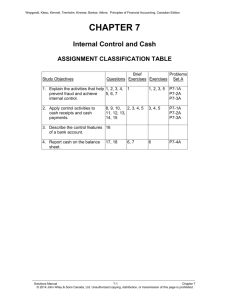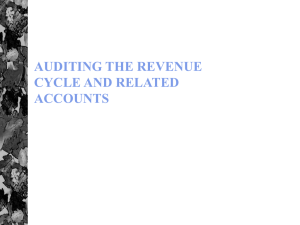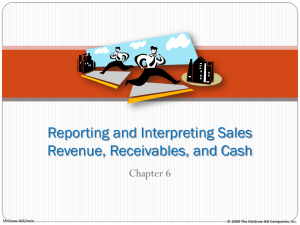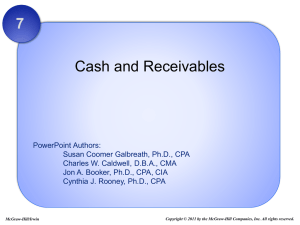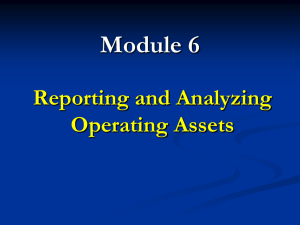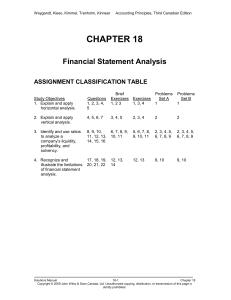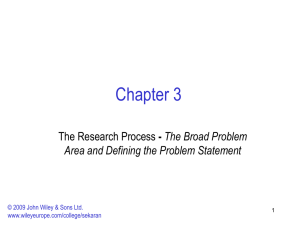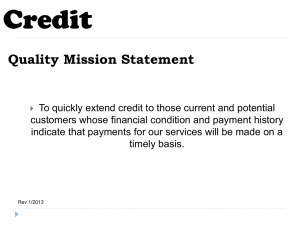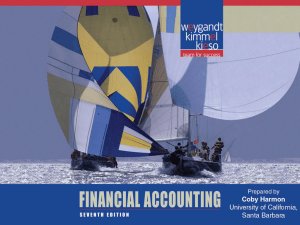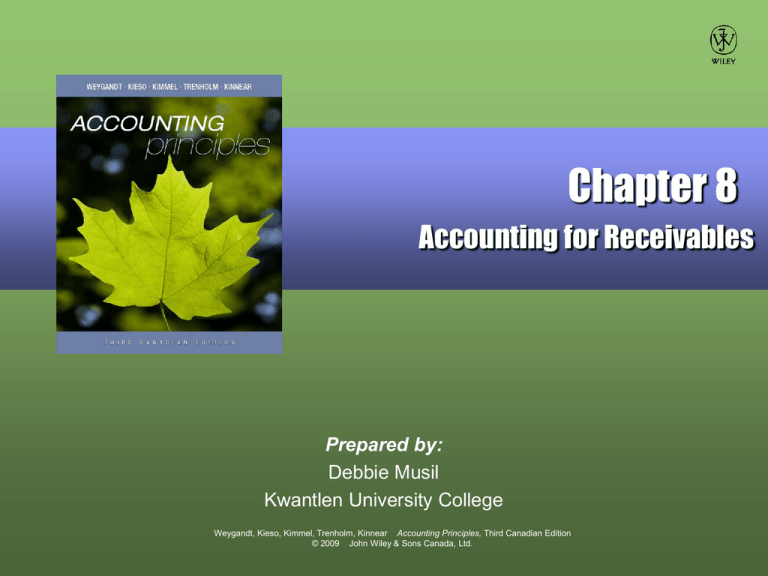
Chapter 8
Accounting for Receivables
Prepared by:
Debbie Musil
Kwantlen University College
Weygandt, Kieso, Kimmel, Trenholm, Kinnear Accounting Principles, Third Canadian Edition
© 2009 John Wiley & Sons Canada, Ltd.
Types of Receivables
•
•
Amounts due from individuals and other
companies
Accounts receivable:
• Amounts owed by customers on account
• Expected to be collected within 30 days
•
Notes receivable:
• Supported by formal instruments of credit
• For periods of 30 days or longer
• Interest bearing
Weygandt, Kieso, Kimmel, Trenholm, Kinnear Accounting Principles, Third Canadian Edition
© 2009 John Wiley & Sons Canada, Ltd.
Recognizing Accounts Receivable
•
A receivable is recorded when:
• Services are provided
• Merchandise is sold on account
July 1 Accounts Receivable - Zellers
Sales
To record sale of merchandise on account.
4 Sales Returns and Allowances
Accounts Receivable - Zellers
To record merchandise returned
Weygandt, Kieso, Kimmel, Trenholm, Kinnear Accounting Principles, Third Canadian Edition
© 2009 John Wiley & Sons Canada, Ltd.
1,000
1,000
100
100
Subsidiary Accounts Receivable
Ledger
•
•
Subsidiary accounts receivable ledger is
used to track individual customer accounts
Each entry is effectively posted twice:
• To the subsidiary ledger
• To the general ledger in summary form
Weygandt, Kieso, Kimmel, Trenholm, Kinnear Accounting Principles, Third Canadian Edition
© 2009 John Wiley & Sons Canada, Ltd.
Other Transactions
•
Other transactions are posted in a similar
manner:
• Account collections
• Interest charged on overdue accounts
July 10 Cash [($1,000 - $100) x 2%]
Sales Discounts [($1,000 - $100) x 2%]
Accounts Receivable - Zellers
To record collection of accounts receivable
Aug. 31 Accounts Receivable - Kids Online
Interest Revenue
To record interest on amount due
Weygandt, Kieso, Kimmel, Trenholm, Kinnear Accounting Principles, Third Canadian Edition
© 2009 John Wiley & Sons Canada, Ltd.
882
18
900
30
30
Nonbank Credit Card Sales
•
Nonbank credit card sales are treated as sales
on account
• Unlike bank credit card sales - treated as cash sales
Oct. 24 Accounts Receivable - Credit Card Company
Credit Card Expense ($500 x 4%)
Sales
To record nonbank credit card sale
480
20
500
• Receipt of cash from nonbank credit cards is
recorded as follows
Nov. 7
Cash
Accounts Receivable - Credit Card Company
To record redemption of credit card billing
Weygandt, Kieso, Kimmel, Trenholm, Kinnear Accounting Principles, Third Canadian Edition
© 2009 John Wiley & Sons Canada, Ltd.
480
480
Valuing Accounts Receivable
•
Some receivables will become uncollectible
• Not reported as assets if no future benefit
• Net realizable value: the collectible amount
•
Receivables are written down to their
collectible amount
• By recording bad debt expense
• In the same period as related revenues are
recorded: matching of revenues and expenses
Weygandt, Kieso, Kimmel, Trenholm, Kinnear Accounting Principles, Third Canadian Edition
© 2009 John Wiley & Sons Canada, Ltd.
The Allowance Method
Three features of allowance method:
1. Amount of uncollectible receivables is
estimated and recorded at end of period
2. Specific amounts determined uncollectible are
written off against the allowance
3. Specific amounts that are recovered are
reversed out of allowance and the collection
recorded
Weygandt, Kieso, Kimmel, Trenholm, Kinnear Accounting Principles, Third Canadian Edition
© 2009 John Wiley & Sons Canada, Ltd.
1. Recording Estimated
Uncollectibles
Dec. 31 Bad Debts Expense
Allowance for Doubtful Accounts
To record estimate of bad debts expense
24,000
Allowance for Doubtful Accounts
•
Deducted from Accounts Receivable in the
current assets section of balance sheet
• Net Realizable value = Accounts Receivable
less Allowance for Doubtful Accounts
Weygandt, Kieso, Kimmel, Trenholm, Kinnear Accounting Principles, Third Canadian Edition
© 2009 John Wiley & Sons Canada, Ltd.
24,000
Two Methods for Estimating the Allowance:
• Percentage of
• Percentage of
Receivables
Sales:
•
•
•
Calculates bad debt
expense as a percentage of
net credit sales
• Based on past
experience and
company’s credit policy
• Example: 2% of credit
sales of $1,200,000 =
$24,000
Better matches revenues
and expenses
Also called the income
statement method
•
•
•
•
Calculates the percentage of
receivables that are
estimated to be uncollectible
• Based on past experience
and credit policy
Can be applied to total
receivables balance or
amounts grouped by age
• Requires an aging
schedule to be prepared
Better estimate of net
realizable value
Also called the balance sheet
method
Weygandt, Kieso, Kimmel, Trenholm, Kinnear Accounting Principles, Third Canadian Edition
© 2009 John Wiley & Sons Canada, Ltd.
Comparison of Approaches
Percentage of Sales
Matching
Sales
Percentage of Receivables
Net Realizable Value
Bad Debts
Expense
Income Statement
Approach
Accounts
Receivable
Allowance
for Doubtful
Accounts
Balance Sheet
Approach
Weygandt, Kieso, Kimmel, Trenholm, Kinnear Accounting Principles, Third Canadian Edition
© 2009 John Wiley & Sons Canada, Ltd.
2. Recording Write-Off of an
Uncollectible Account
Mar. 1 Allowance for Doubtful Accounts
Accounts Receivable - Kids Online
Write-off of uncollectible account
4,500
4,500
3. Recovery of an Uncollectible Account
July 1 Accounts Receivable - Kids Online
Allowance for Doubtful Accounts
To reverse write-off of Kids Online account
4,500
July 1 Cash
Accounts Receivable - Kids Online
To record collection from Kids Online
4,500
Weygandt, Kieso, Kimmel, Trenholm, Kinnear Accounting Principles, Third Canadian Edition
© 2009 John Wiley & Sons Canada, Ltd.
4,500
4,500
Recognizing Notes Receivable
•
A written promise to pay a specified amount of
money on demand or at a definite time
• If note is received to settle an outstanding
account receivable:
May 31 Notes Receivable - Higly
Accounts Receivable - Higly
To record acceptance of Higly note
10,000
10,000
•
If received for cash, debit is to Cash
• Notes are valued at net realizable value
• Similar process to determine bad debt expense and
allowance as for accounts receivable
Weygandt, Kieso, Kimmel, Trenholm, Kinnear Accounting Principles, Third Canadian Edition
© 2009 John Wiley & Sons Canada, Ltd.
Recording Interest
•
Formula for calculating interest:
Principal
of Note
X
Annual
Interest
Rate
X
Time in
Terms of
One Year
=
Interest
• An annual rate of interest - to determine monthly
interest, divide by twelve
•
Separate interest receivable account is used
(value of note is not altered)
June 30 Interest Receivable
Interest Revenue ($10,000 x 6% x 1/12)
To accrue interest on Higly note
Weygandt, Kieso, Kimmel, Trenholm, Kinnear Accounting Principles, Third Canadian Edition
© 2009 John Wiley & Sons Canada, Ltd.
50
50
Disposing of Notes Receivable
•
A note is honoured when paid in full on its
maturity date
Sept. 30 Cash
Notes Receivable - Higly
Interest Revenue ($10,000 x 6% x 3/12)
Interest Receivable
To record collection of Higly note
•
10,200
10,000
150
50
A note is dishonoured if not paid in full at
maturity
Sept. 30 Accounts Receivable - Higly
Notes Receivable - Higly
Interest Revenue
Interest Receivable
To record dishonouring of Highly note, collection expected
Weygandt, Kieso, Kimmel, Trenholm, Kinnear Accounting Principles, Third Canadian Edition
© 2009 John Wiley & Sons Canada, Ltd.
10,200
10,000
150
50
Disposing of Notes Receivable 2
•
A note is dishonoured if not paid in full at
maturity
Sept. 30 Accounts Receivable - Higly
Notes Receivable - Higly
Interest Revenue
Interest Receivable
To record dishonouring of Highly note, collection expected
Weygandt, Kieso, Kimmel, Trenholm, Kinnear Accounting Principles, Third Canadian Edition
© 2009 John Wiley & Sons Canada, Ltd.
10,200
10,000
150
50
Management of Receivables
Receivables turnover ratio:
= Net Credit Sales ÷ Average Receivables
• Measures the number of times that receivables are collected in a
period
• Higher the number, the more liquid are receivables
Collection period:
= 365 ÷ Receivables Turnover Ratio
• Calculates the average number of days that accounts receivable
are outstanding
Operating Cycle:
= Days Sales in Inventory + Collection Period
• Calculates the number of days to complete the operating cycle
• Purchase of inventory through collection of cash
Weygandt, Kieso, Kimmel, Trenholm, Kinnear Accounting Principles, Third Canadian Edition
© 2009 John Wiley & Sons Canada, Ltd.
COPYRIGHT
Copyright © 2009 John Wiley & Sons Canada, Ltd. All rights
reserved. Reproduction or translation of this work beyond that
permitted by Access Copyright (The Canadian Copyright
Licensing Agency) is unlawful.
Requests for further
information should be addressed to the Permissions
Department, John Wiley & Sons Canada, Ltd. The purchaser
may make back-up copies for his or her own use only and not
for distribution or resale. The author and the publisher
assume no responsibility for errors, omissions, or damages
caused by the use of these programs or from the use of the
information contained herein.
Weygandt, Kieso, Kimmel, Trenholm, Kinnear Accounting Principles, Third Canadian Edition
© 2009 John Wiley & Sons Canada, Ltd.

